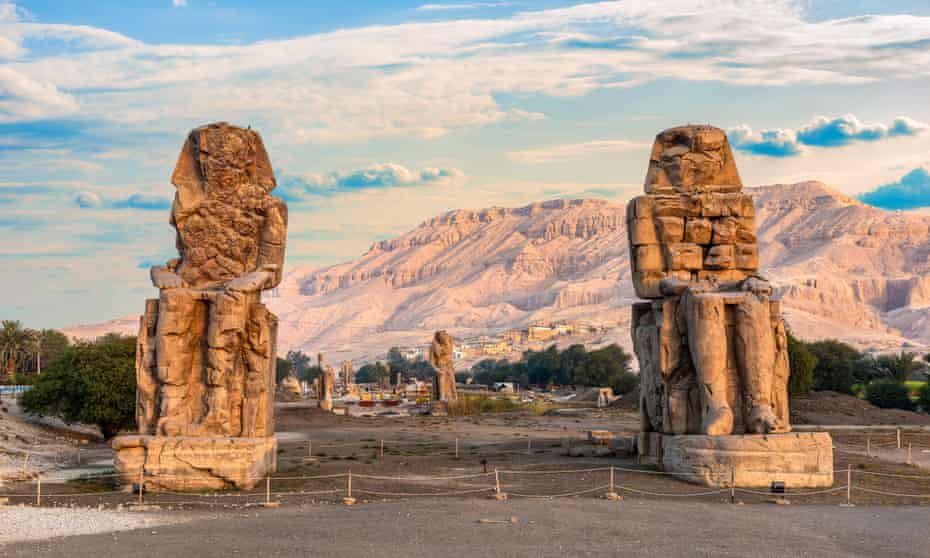Introduction to the Colossi of Memnon
The Colossi of Memnon stand as monumental guardians of the ancient city of Thebes, now modern-day Luxor, Egypt. These two massive statues, each representing Pharaoh Amenhotep III, have captivated the imaginations of scholars, tourists, and historians alike since their construction during the 14th century BC. Originally intended to showcase the power and divine right of Amenhotep III, the statues have come to symbolize the grandeur of ancient Egyptian civilization and its artistic prowess.
Each Colossus towers approximately 18 meters (59 feet) in height, constructed predominantly from quartzite sandstone, which was quarried near Cairo and transported to Luxor. These statues depict the pharaoh seated on a throne, wearing the traditional royal regalia, including the nemes headdress and the sidelock of youth, signifying his divine lineage. Their imposing presence is enhanced by the surrounding temple complex, which was once a hub of worship and a center for the veneration of the deceased ruler.
Although the temple’s structure largely succumbed to the ravages of time and natural elements, the Colossi themselves have endured, albeit with some damage. One of the statues became associated with the legend of Memnon, a mythical figure in Greek mythology. It was said that, upon the rising sun, the statue emitted a haunting sound, which travelers interpreted as the voice of Memnon calling out to his mother, the goddess Eos. This legend drew numerous visitors to the site during the Roman era, further solidifying the statues’ historical and mythical significance.
The Colossi of Memnon not only represent the artistic and architectural achievements of ancient Egypt but also serve as a poignant reminder of the civilization’s enduring legacy. Their imposing nature continues to awe visitors, evoking a sense of wonder that aligns them with the world’s greatest wonders. As a testament to Pharaoh Amenhotep III’s reign, these colossal figures resonate deeply, embodying both historical reverence and cultural significance.
The Artistic and Architectural Marvel
The Colossi of Memnon, towering at an impressive height of approximately 18 meters, stand as testament to the artistic and architectural capabilities of ancient Egyptian civilization. These two gigantic statues, which depict Pharaoh Amenhotep III, showcase not only his physical attributes but also represent the reverence and power of this Egyptian ruler. The meticulous craftsmanship evident in their construction is a remarkable feat, reflecting the sophistication of artistry during the 14th century BCE.
Constructed from quartzite sandstone, the choice of material is significant, as it highlights the availability of local resources and the ingenuity of ancient Egyptian builders. Each statue is carved from a single block of stone, which demonstrates an exemplary understanding of the qualities of the material, ensuring durability against the ravages of time and environment. The detailed features of the statues, from facial expressions to intricate clothing designs, convey the artistic prowess that ancient artisans possessed, elevating these monuments to a status of national pride and cultural identity.
Moreover, the symbolism embedded within the design of the Colossi is deeply intertwined with ancient Egyptian religious beliefs. Positioned near the mortuary temple of Amenhotep III, these statues are more than mere representations of the pharaoh; they serve as guardians of his legacy and as representations of the divine power bestowed upon him. The presence of the statues also embodies royal ideology, where the pharaoh was considered a god-king, bridging the gap between the earthly and the divine. This seamless integration of art, architecture, and cultural symbolism makes the Colossi of Memnon a profound representation of ancient Egyptian society and its enduring legacy.
Personal Experience and Connection
My first encounter with the Colossi of Memnon was a moment etched in my memory, an experience that transcended mere tourism. As I stood before these colossal statues, I was immediately struck by their magnitude and the intricate details that had withstood the test of time. The sheer scale of the figures, towering above me, imbued me with a sense of humility and wonder. It was as if I was not just observing history, but rather partaking in it, standing in the presence of ancient guardians of the past.
The serene atmosphere that enveloped the site further enhanced the emotional impact of my visit. Nestled against the backdrop of the sun-kissed Valley of the Kings, the gentle whisper of the wind and the distant sounds of nature created a tranquil setting. The surrounding landscape, with its golden hues and rich textures, felt almost dreamlike, transporting me back to an era when these statues first held significance for the people of ancient Egypt. I felt a profound connection to those who had once revered these colossi, a connection that transcended centuries.
As I contemplated the history encapsulated within the stone, thoughts about time and human endeavor washed over me. These magnificent structures, built to honor Pharaoh Amenhotep III, carried with them the weight of legacy, the stories of countless generations who had stood where I stood. The Colossi of Memnon served as a reminder of the fragility of human life and achievement, yet they also represented resilience, reminding us that greatness can endure the relentless passage of time. This personal experience solidified the statues’ place in my heart as my chosen wonder of the world, a testament to the enduring spirit of humanity and its quest for immortality through art and monument.
Legacy and Preservation of the Colossi
The Colossi of Memnon, two monumental statues standing sentinel at the entrance of the mortuary temple of Amenhotep III, are not only remarkable works of art but also integral to Egypt’s cultural heritage. Their legacy extends beyond mere historical significance; they play a vital role in the local economy, primarily through tourism. Millions of visitors travel to Egypt each year, drawn by the allure of these ancient wonders and the stories they tell. This influx of tourists provides much-needed revenue to local communities, supporting businesses and encouraging the preservation of cultural heritage. The local guides and craftspeople, heavily reliant on this tourist interest, actively participate in the ongoing narrative of the Colossi, enhancing the experience for visitors.
However, the majestic statues face numerous challenges that threaten their integrity. Natural erosion caused by wind and sand continues to wear away the surface details, while human activity contributes to their deterioration. The increasing foot traffic from tourists, along with environmental factors such as pollution and climate change, presents significant risks to the structures. Efforts to mitigate these impacts are crucial to ensure the preservation of the statues for future generations. Initiatives to limit access to sensitive areas and implement protective measures have been introduced to combat these challenges effectively.
The preservation of the Colossi of Memnon is vital not only for the statues themselves but also for the cultural narrative they represent. By safeguarding these ancient monuments, we ensure that their stories and aesthetic grandeur are handed down to future generations. The ongoing commitment to restoration and protection reflects a dedication to maintaining Egypt’s historical legacy. In conclusion, the Colossi of Memnon are more than just relics of the past; they are enduring symbols of human achievement and cultural resilience that deserve thoughtful preservation efforts.


